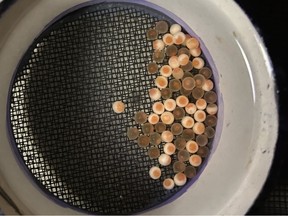The UBC data suggests salting roads at current levels in November or December is likely dangerous to coho and chum salmon.

Recommended Videos
The study — a collaboration among the University of B.C., Simon Fraser University, the B.C. Institute of Technology, the federal government, community scientists and stream keepers — involved monitoring salt in more than 30 streams in Metro Vancouver.
Clare Kilgour, who is working on her master’s degree in zoology at UBC, said researchers measured salt in streams and found there are surges in the winter. She said the largest pulse of salt was 10 times B.C.’s acute water quality guideline for chloride in freshwater systems.
Road salt is made up of sodium and chloride. When it dissolves on the road, it seeps into groundwater and streams.
Kilgour said high concentrations of chloride were found in streams during the winter. Some were notably bad, such as Serpentine Creek in Surrey and Stoney Creek in Burnaby.
“This study started because some very dedicated stream keepers at Stoney Creek had been tracking this issue for years, and had done some investigation on their own,” said Kilgour.
“So they came together and said ‘we think that there’s a problem here.’ They brought it to researchers at UBC, SFU and BCIT and that got the ball rolling.”
The guidelines state a safe limit is 600 milligrams a litre but in some cases up to 6,000 milligrams a litre was found by the researchers.
The scientists then recreated the salt pulses in the lab, exposing coho salmon eggs to one salt pulse either shortly after fertilization or once they hatched. What they found was they were more likely to die in the egg stage than after they had hatched.
UBC researcher Carley Winter, also working on her master’s degree, said they started seeing the fertilized eggs dying at 1,200 milligrams a litre and higher.
“And that’s only double B.C.’s guideline for the amount of salt or chloride in water but we see concentrations going up to 10 times that guideline,” said Winter.
The study suggests exposure to salt pulses for 24 hours caused 70 per cent of coho eggs to die, but hatched fish had better survival rates.
The preliminary data suggests that salting roads at current levels in November or December, when many salmon embryos are developing in streams and creeks, could be contributing to low population of chum and coho.

Kilgour said they are studying how many eggs were lost to the high levels of salt in the winter but that information will likely be part of the final study report.
Both Winter and Kilgour said they are not advocating eliminating salt on roads because it’s a safety issue, but hope the research will lead to better practices such as using brine or beet wastewater, or reducing salt use.
“You only need around two tablespoons of salt per square metre, and that’s pretty effective,” said Winter.
Kilgour said they plan to investigate how excessive levels of salt affect the salmon eggs and the growth of fry that don’t die.
Next winter, researchers at SFU will look at how road salt affects coho hatching.